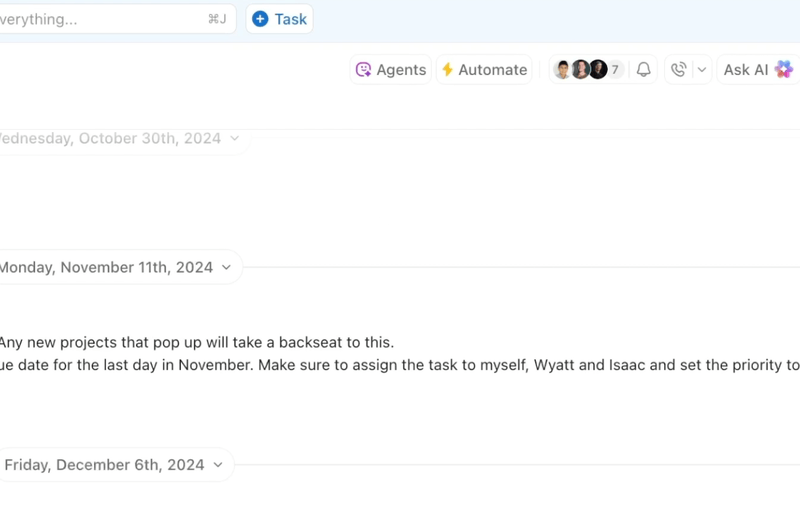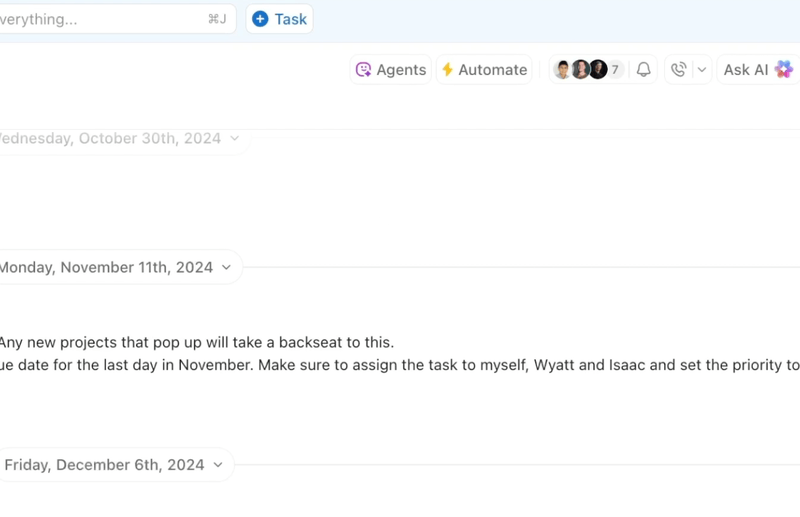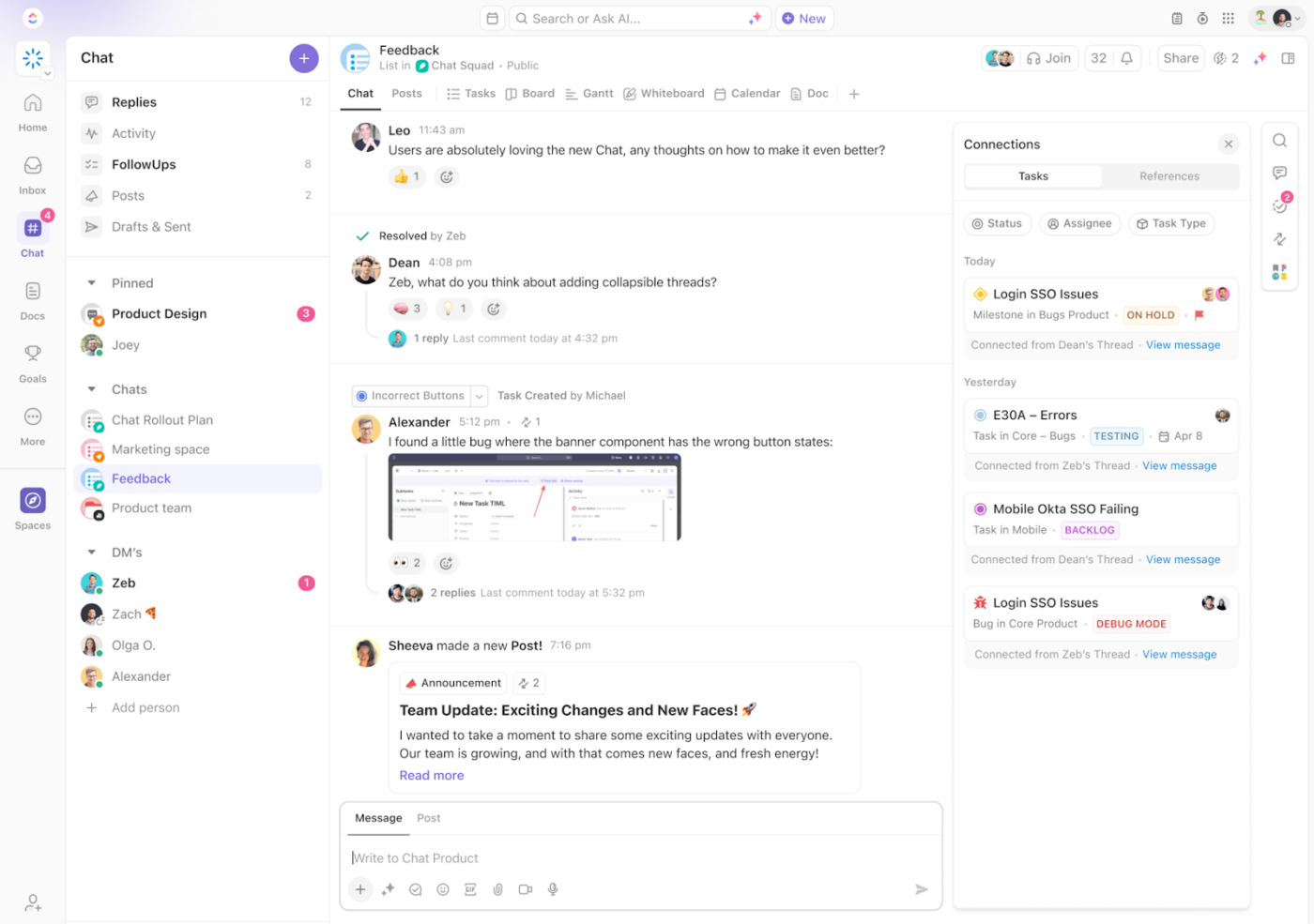AI Agent vs Chatbot: Key Differences and Which One is Right for You?

Sorry, there were no results found for “”
Sorry, there were no results found for “”
Sorry, there were no results found for “”

AI Agent vs Chatbot isn’t just a technical comparison anymore. It’s a real decision businesses face when rethinking how they communicate, automate, and scale. As AI technologies continue to power everything from instant customer replies to automated task management, understanding what these tools can (and can’t) do is more important than ever.
We’ve come a long way from the early days of ELIZA, the first chatbot built on simple decision trees. Today’s systems leverage natural language processing, machine learning, and massive datasets to not only talk but act.
You’ll see AI chatbots embedded in websites, apps, and customer service platforms. But behind more adaptive workflows and intelligent decisions, AI agents—especially those like ClickUp AI Agents—often do the heavy lifting by reasoning, acting, and adapting across your workspace.
In this blog, we’ll break down the key differences, practical use cases, and how to choose the right fit based on what your business actually needs.
Confused between an AI chatbot and an AI agent? Here’s how to make the right call and scale smarter:
Use effective tools to bring agentic execution into your workspace and move work forward without the bottlenecks.
They’re everywhere, from product pages to support popups. AI chatbots have become the default layer of communication between companies and customers. But what are they actually doing under the hood?
At the simplest level, an AI chatbot is a software tool that uses natural language processing to interpret user inputs and respond with relevant, structured output.
Unlike traditional bots that follow rigid flows, modern chatbots respond more intelligently using machine learning models and existing data.
Key characteristics include:
Most AI chatbots are used for high-volume, repeatable interactions where consistency and speed matter more than complexity.
The earliest chatbot, ELIZA, followed simple decision trees to mimic a conversation without actually understanding the context.
For decades, most bots worked the same way: trigger > reply > end of script.
That changed with the rise of deep learning and large language models. Tools like ChatGPT can now:
Still, even with these advancements, chatbots and AI agents differ significantly.
📖 Also Read: Chatbot vs Conversational AI
Modern chatbots use a combination of:
They can pull from chat logs, recognize basic emotions, and offer quick answers, but they don’t adapt dynamically, and they don’t solve complex problems on their own.
That’s where AI agents come in, and we’ll get to that. But first, let’s look at the most common and effective use cases for AI chatbots in business.
AI chatbots are often the first touchpoint between your business and its customers. They’re built for volume, consistency, and speed when the problems are predictable.
Whether it’s a product page or a support portal, AI chatbots are handling customer queries round the clock. They’re trained to recognize intent, offer quick answers, and maintain consistent responses across channels without escalating every question to a live agent.
Use cases here typically include:
These bots work well when the interaction doesn’t require deep logic or decision-making, just fast, reliable service.
👀 Did You Know? According to a report, up to 70% of routine customer questions can be handled by AI-powered chatbots, freeing up human agents for more complex tasks.
Chatbots bring relief to teams dealing with repetitive tasks. They automate processes like:
This makes them a cost-effective solution for businesses aiming to reduce workload without compromising responsiveness.
Check out this video to know more about automating tasks with AI 👇
While most people associate AI chatbots with customer service, they’re just as useful inside the organization. From onboarding workflows to answering policy questions, chatbots can serve as AI-powered support for employees too.
They can:
That said, these bots still operate within a fixed boundary. They’re effective at task-specific automation. But in a comparison of virtual agents vs AI chatbots, it’s clear which one handles broader complexity.
Next up, let’s explore what that complexity looks like with AI agents.
📖 Read More: How to Ask AI a Question?
If chatbots are designed to respond, AI agents are built to act. They go beyond scripted conversations and operate with autonomy, handling complex problems, navigating systems, and making decisions based on context awareness.
An AI agent is a system that uses artificial intelligence, machine learning, and real-time data to perform tasks independently. Unlike chatbots, which follow predefined flows, AI agents:
They’re not just reacting, but they’re reasoning.
AI agents typically interact across multiple platforms, pulling from multiple data sources and adapting to user inputs without needing constant oversight. This makes them ideal for business processes where the path isn’t fixed, and the variables keep shifting.
While there are many flavors of AI agents, the most effective ones share these core capabilities:
Where AI chatbots follow scripts, AI agents offer real-time flexibility. They know when to escalate, when to re-route, and when to act without asking.
You’ll see AI agents embedded in systems that do more than deliver answers, they solve, predict, and optimize.
Think of:
The rise of AI agents represents a shift from support to strategy. They’re not just saving time; they’re actively guiding outcomes.
And if you’re weighing virtual agent vs AI chatbot, this is where the differences become impossible to ignore.
📖 Also Read: Best AI Apps to Optimize Workflows
AI agents shine when the task isn’t just to respond but to reason, adapt, and act. Their value shows up in scenarios where the process is dynamic, decisions matter, and business needs go beyond surface-level automation.
Unlike chatbots, AI agents can perform tasks that span multiple systems and involve multiple decisions.
For example:
This ability to manage complex workflows is one of their most advanced capabilities—especially in environments where rules change often.
AI agents can make context-based decisions without manual prompts. They use a blend of:
Use cases include:
This is where the line between an AI tool and an intelligent decision-maker starts to blur.
AI agents aren’t just helpful; they’re transformative in enhancing productivity. Think of them as cross-functional assistants that:
They’re especially valuable for high-velocity teams managing business processes that require precision and speed.
And because they continuously adapt, the more you use them, the better they get—something traditional chatbots and even some advanced automation simply can’t match.
Next, we’ll directly compare AI agents and AI chatbots, including their capabilities, scope, limitations, and what actually matters when choosing the right solution.
📖 Also Read: AI Uses Cases & Applications for Enterprise Teams
They both speak in natural language. Both automate conversations. But the real difference between AI chatbots and AI agents isn’t how they talk, rather it’s how they think, act, and evolve.
Here’s a breakdown of where the gap widens and what it means for your business.
AI chatbots are designed to respond to requests. That’s it. Whether it’s answering FAQs or walking a user through a form, the task ends where the conversation ends. They can’t adapt, improvise, or connect the dots across tools.
AI agents, on the other hand, can:
For example, a chatbot might confirm a delivery address. An AI agent would notice delays in the logistics platform, alert the customer, assign an internal task, and update the CRM—all without a prompt.
That’s the shift from conversation to decision-making.
👀 Did You Know: One chatbot famously passed a Turing Test by pretending to be a 13-year-old boy. Its limited vocabulary and simplistic responses made its scripted answers feel more authentic and believable.
Most AI chatbots rely on predefined scripts and training data. They don’t learn unless someone updates them. That’s a problem when customer behavior, expectations, and products change fast.
AI agents improve over time. They use:
You’re not just getting automation; you’re building an agent that gets smarter every week. That makes them a better fit for businesses managing unstructured data, complex problems, or constantly evolving processes.
Chatbots shine in high-volume, low-stakes scenarios like order tracking, password resets, and product questions. But they stay siloed in a single interface, disconnected from the rest of your operation.
AI agents integrate deeply with multiple data sources, internal tools, and your team’s existing workflows. They’re built for:
If your goal is to enhance productivity, reduce manual coordination, or let teams focus on strategy, chatbots won’t get you there.
When the stakes are low, a chatbot giving a wrong answer is just an annoyance. But when you’re running product ops, managing enterprise projects, or handling real-time support escalations, “good enough” doesn’t cut it.
AI agents:
That’s why companies looking to automate mission-critical workflows are shifting to agents—not just for convenience but for outcome ownership.
The bottom line? If you want consistency at scale, a chatbot might be enough. But if you need context, control, and continuous improvement, AI agents offer capabilities a chatbot simply can’t match.
😎 Fun Read: How to Use Human-Centric AI in the Workplace
Choosing between a chatbot and an agent isn’t about features. It’s about how much ownership you expect from your AI.
If you want something that responds, a chatbot works. And if you want something that acts, decides, and scales with your business, you’re in AI agent territory.
But let’s dig deeper. Here’s how to really think about the difference.
Chatbots are excellent at managing high volumes of repeatable tasks.
Think FAQs, appointment scheduling, and lead capture. Basically, tasks where the user journey is known, and there’s one right answer.
But what if your process changes based on customer profile, urgency, or task dependencies?
An AI agent doesn’t just handle inputs. It evaluates context, reroutes priorities, and triggers workflows automatically. If your business relies on adaptive logic, decision trees won’t cut it. Then you definitely need a reasoning engine.
Chatbots operate best when they’re pulling from structured clean data like a knowledge base, product catalog, and help docs.
Agents can pull from multiple data sources, mix in unstructured data, and interpret real-time signals.
They don’t just find the answer but also figure out what needs to be done. This is based on everything else happening in your system.
So, whether you’re juggling layered datasets, shifting timelines, or dependencies across teams, agents always win.
This is where most teams make the wrong call.
If you’re focused on reducing response time, chatbots are perfect. But if you care about closing the loop, like getting a task resolved, workflow completed, or a decision executed, then you’re not looking for a conversation. You’re looking for autonomous action.
AI agents don’t just guide users. They act on behalf of your team based on rules, logic, and context.
Chatbots are often sold as a cost-effective solution, and they are at first. But every time you need a new flow, new integration, or smarter routing, someone has to go in and rewrite it.
AI agents learn from experience, improve with usage, and scale with complexity. They’re designed for business processes that evolve, not stay static.
If you’re solving for speed, structure, or surface-level support, chatbots will do the job. But if you’re building toward automation that thinks, systems that adapt, and AI that owns the outcome, then you’re building with agents.
ClickUp AI Agents are autonomous, intelligent assistants designed to do more than automate repetitive tasks—they reason, adapt, and act across your entire workspace. Unlike traditional chatbots or rule-based automation, ClickUp AI Agents can understand context, make decisions, and execute multi-step workflows without manual intervention.
And with ClickUp Brain Max, your AI agents get an upgrade: you can dictate actions with Talk to Text, switch between leading AI models for speed or precision, and even extend intelligence into any desktop app. That’s agentic execution, amplified.

Real-world use cases for ClickUp AI Agents
💡 Pro Tip: ClickUp Automations are perfect for structured, rule-based workflows. For dynamic, context-aware execution that adapts as your business evolves, ClickUp AI Agents are the next level.
💡 Pro Tip: Want ClickUp Brain’s AI anywhere on your computer? Brain Max brings ClickUp’s AI to your desktop, so you can access powerful AI features across any app—not just inside ClickUp.
With ClickUp AI Agents, you’re not just automating tasks—you’re empowering your business with intelligent, adaptive systems that drive outcomes, not just conversations.

Most AI agents are only as good as the systems they trigger. ClickUp Automations gives you the power to build agentic workflows that execute across tasks, docs, comments, and teams, without writing a single line of code.
You can:
AI agents thrive when they can think in context. ClickUp Brain brings that context to the surface.
Whether it’s summarizing a meeting doc, suggesting next steps, or answering a task-specific question, ClickUp Brain lets your AI agent access:
Instead of building another static decision tree, you’re building a reasoning layer that updates as the work evolves.


Even with automation, not everything should be handled in isolation. Some updates need feedback, clarification, or a human signal.
ClickUp Chat gives AI agents a space to interact with your team in real time:
AI Agents don’t replace collaboration. Rather, they accelerate it.
Every AI agent needs a knowledge base. Tools like ClickUp AI Notetaker and ClickUp Docs turn scattered updates into living, searchable contexts that AI can use to make smarter decisions.
You can:
It’s not just documentation. It’s operational memory.

AI agents are there to build workflows that evolve, self-correct, and accelerate execution. ClickUp gives you the tools to bring that vision to life with no patchwork or silos.
The AI agent vs chatbot debate is futile because conversational AI isn’t one-size-fits-all. AI chatbots and AI agents serve fundamentally different roles. Chatbots help you respond faster and automate surface-level interactions. AI agents go further. They adapt, reason, and take action across complex workflows.
If your business grows in complexity, velocity, or ambition, relying on scripted tools won’t be enough. You need systems that think.
That’s where ClickUp comes in. From task automation to real-time insights and intelligent collaboration, ClickUp gives you everything you need to build, deploy, and scale powerful AI agents.
© 2025 ClickUp